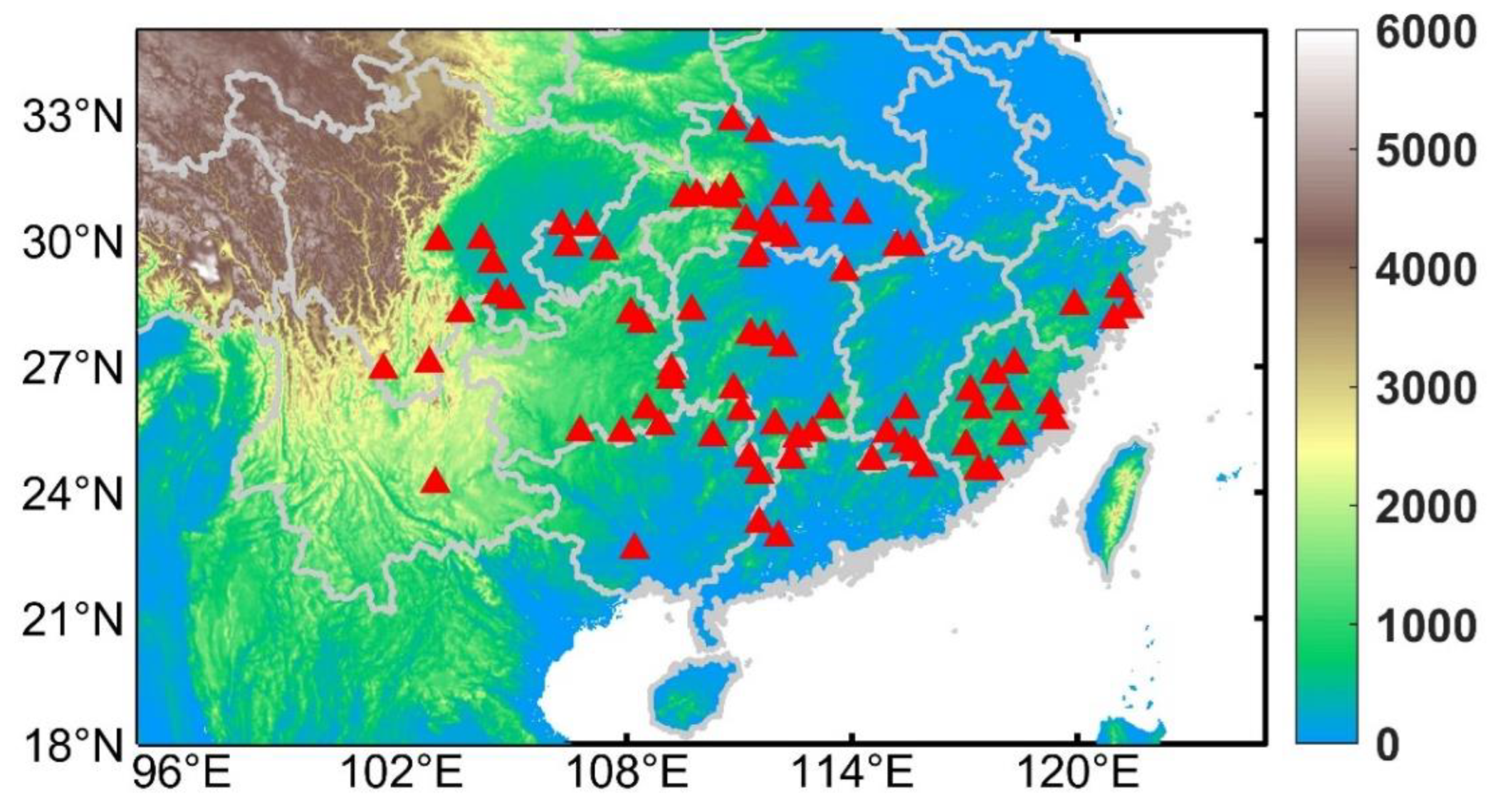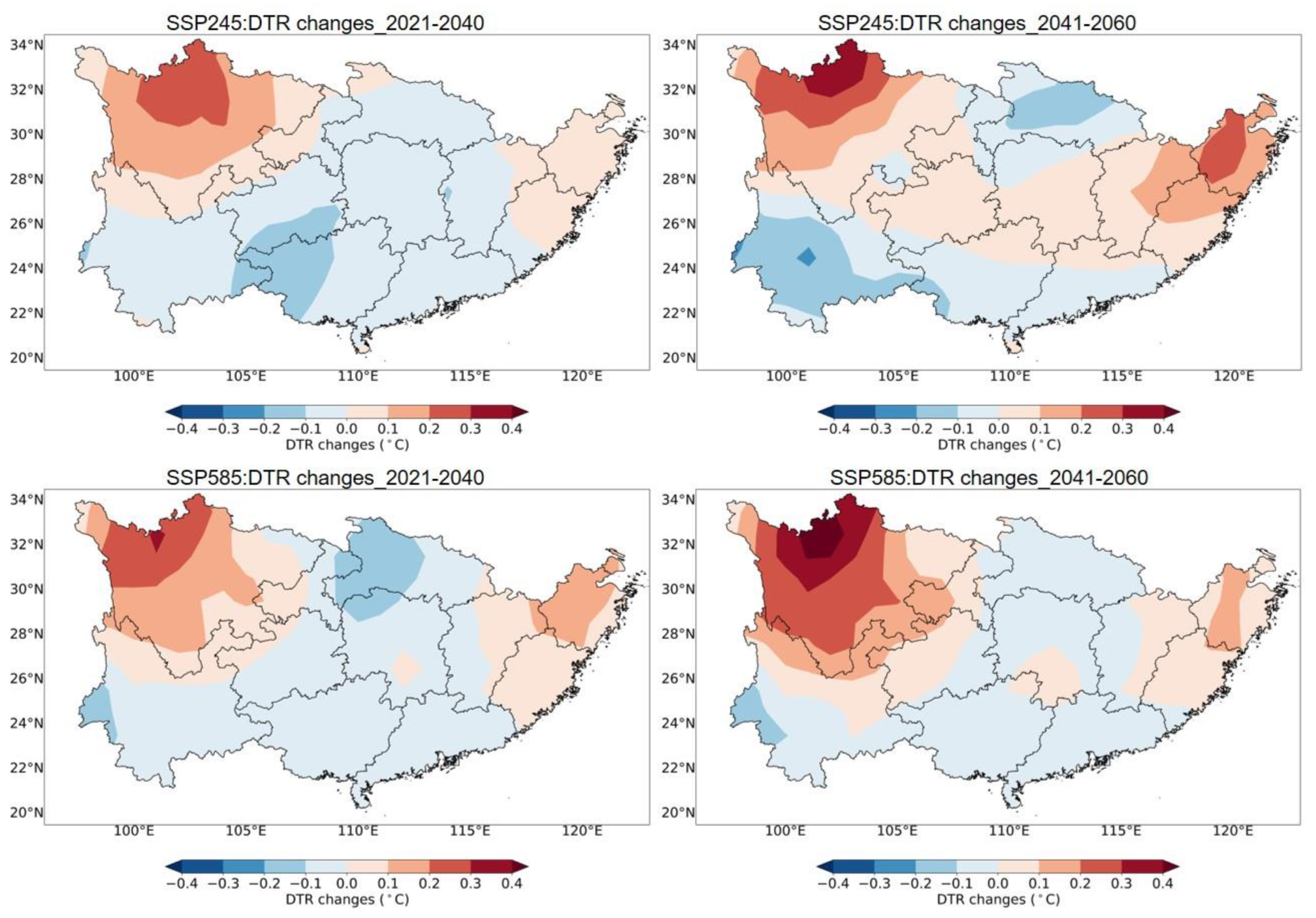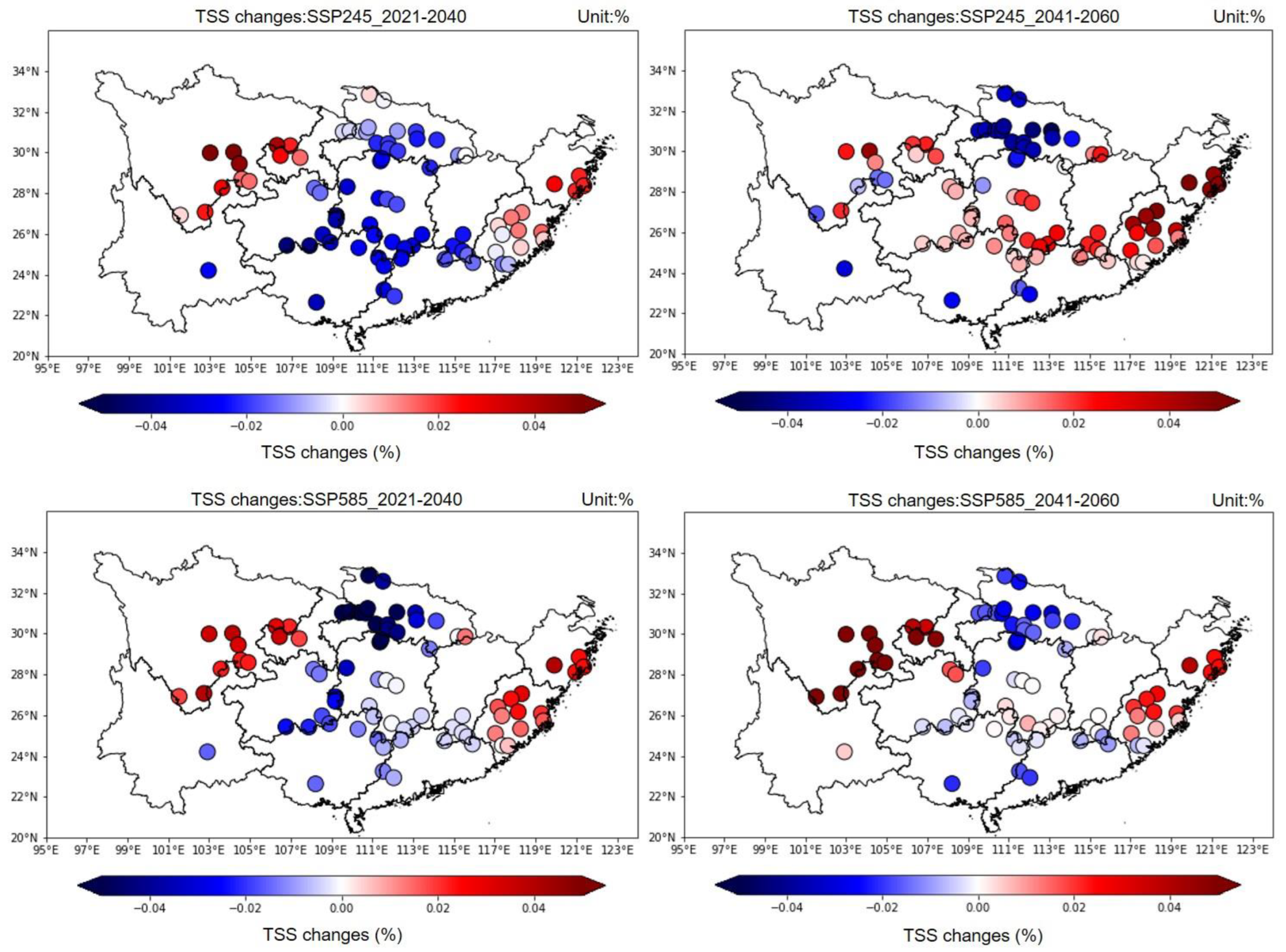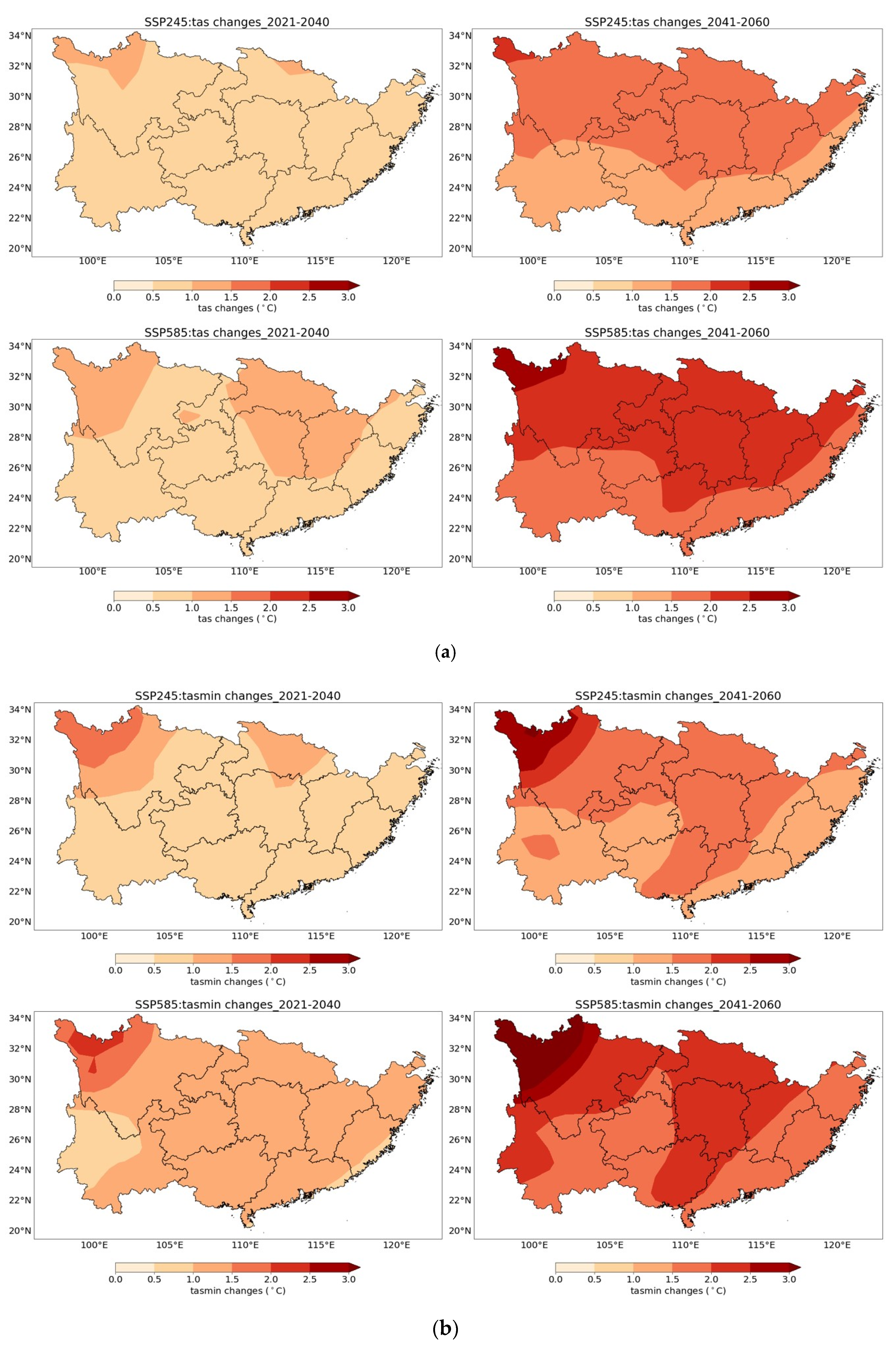Effects of Future Climate Change on Citrus Quality and Yield in China
Abstract
:1. Introduction
2. Materials and Methods
2.1. Study Area
2.2. Data Sources
2.2.1. Statistical Data
2.2.2. Meteorological Observation Data
2.2.3. CMIP6 Data
2.3. Methods
2.3.1. Meta-Analysis
2.3.2. Correlation Analysis
2.3.3. Least Square Estimation
2.3.4. Bilinear Interpolation and Multimodel Ensemble
3. Results
3.1. Changes of Quality in the Climate Change Factors
3.1.1. Quality in Relation to Climate Variables
3.1.2. Changes in the Future DTR
3.1.3. Changes in the future TSS
3.2. Changes of Yield in the Climate Change Factors
3.2.1. Yield in Relation to Climate Variables
3.2.2. Changes in the Future Climate Factors
3.2.3. Changes in the Future Yield
3.3. Changes of Quality-Yield in the Climate Change Factors
4. Discussion
4.1. Impact Mechanisms of Empirical Models for Predicting Citrus Fruit Quality and Yield
4.2. Sensitive Areas Affected by Climate Factors in the Future
4.3. Some Measures May Improve Citrus Quality and Yield
4.4. Limitations of this Study
5. Conclusions
Supplementary Materials
Author Contributions
Funding
Institutional Review Board Statement
Informed Consent Statement
Data Availability Statement
Acknowledgments
Conflicts of Interest
References
- Stocker, T.F.; Qin, D.; Plattner, G.-K.; Tignor, M.; Allen, S.K.; Boschung, J.; Nauels, A.; Xia, Y.; Bex, V.; Midgley, P.M. (Eds.) IPCC Climate Change 2013: The Physical Science Basis. Contribution of Working Group I to the Fifth Assessment Report of the Intergovernmental Panel on Climate Change; Cambridge University Press: Cambridge, UK, 2013. [Google Scholar]
- Piao, S.; Ciais, P.; Huang, Y.; Shen, Z.; Peng, S.; Li, J.; Zhou, L.; Liu, H.; Ma, Y.; Ding, Y.; et al. The impacts of climate change on water resources and agriculture in China. Nature 2010, 467, 43–51. [Google Scholar] [CrossRef] [PubMed]
- Adams, R.M.; Rosenzweig, C.; Peart, R.M.; Ritchie, J.T.; McCarl, B.A.; Glyer, J.D.; Curry, R.B.; Jones, J.W.; Boote, K.; Allen, L.H. Global climate change and US agriculture. Nature 1990, 345, 219–224. [Google Scholar] [CrossRef]
- Salinger, M. Climate variability and change: Past, present and future: An overview. Clim. Change 2005, 70, 9–29. [Google Scholar] [CrossRef]
- Rosenzweig, C.; Phillips, J.; Goldberg, R.; Carroll, J.; Hodges, T. Potential impacts of climate change on citrus and potato production in the US. Agric. Syst. 1996, 52, 455–479. [Google Scholar] [CrossRef]
- Furuya, J.; Koyama, O. Impacts of Climatic Change on World Agricultural Product Markets: Estimation of Macro Yield Functions. Jpn. Agric. Res. Q. JARQ 2005, 39, 121–134. [Google Scholar] [CrossRef] [Green Version]
- Parry, M.; Rosenzweig, C.; Livermore, M. Climate change, global food supply and risk of hunger. Philos. Trans. R. Soc. B Biol. Sci. 2005, 360, 2125–2138. [Google Scholar] [CrossRef] [PubMed] [Green Version]
- Lobell, D.B.; Schlenker, W.; Costa-Roberts, J. Climate Trends and Global Crop Production since 1980. Science 2011, 333, 616–620. [Google Scholar] [CrossRef] [PubMed] [Green Version]
- Lesk, C.; Rowhani, P.; Ramankutty, N. Influence of extreme weather disasters on global crop production. Nature 2016, 529, 84–87. [Google Scholar] [CrossRef] [PubMed]
- Xie, Q.; Li, J. Effect of Indian Ocean-Pacific SST Pattern in Autumn on Winter Wheat Climatic Yield in the North China Plain in the Following Year and a Possible Mechanism. Sci. Rep. 2019, 9, 19016. [Google Scholar] [CrossRef] [PubMed] [Green Version]
- Ceglar, A.; Toreti, A.; Lecerf, R.; Van der Velde, M.; Dentener, F. Impact of meteorological drivers on regional inter-annual crop yield variability in France. Agric. For. Meteorol. 2016, 216, 58–67. [Google Scholar] [CrossRef]
- Peña-Gallardo, M.; Vicente-Serrano, S.M.; Quiring, S.; Svoboda, M.; Hannaford, J.; Tomas-Burguera, M.; Martín-Hernández, N.; Domínguez-Castro, F.; El Kenawy, A. Response of crop yield to different time-scales of drought in the United States: Spatio-temporal patterns and climatic and environmental drivers. Agric. For. Meteorol. 2019, 264, 40–55. [Google Scholar] [CrossRef] [Green Version]
- Feng, S.; Hao, Z.; Zhang, X.; Hao, F. Changes in climate-crop yield relationships affect risks of crop yield reduction. Agric. For. Meteorol. 2021, 304–305, 108401. [Google Scholar] [CrossRef]
- Tao, F.; Hayashi, Y.; Zhang, Z.; Sakamoto, T.; Yokozawa, M. Global warming, rice production, and water use in China: Developing a probabilistic assessment. Agric. For. Meteorol. 2008, 148, 94–110. [Google Scholar] [CrossRef]
- Campbell, B.M.; Vermeulen, S.J.; Aggarwal, P.K.; Corner-Dolloff, C.; Girvetz, E.; Loboguerrero, A.M.; Ramirez-Villegas, J.; Rosenstock, T.; Sebastian, L.; Thornton, P.K.; et al. Reducing risks to food security from climate change. Glob. Food Secur. 2016, 11, 34–43. [Google Scholar] [CrossRef] [Green Version]
- Lobell, D.B.; Asner, G.P. Climate and management contributions to recent trends in US agricultural yields. Science 2003, 299, 1032. [Google Scholar] [CrossRef]
- Lu, J.; Carbone, G.J.; Gao, P. Detrending crop yield data for spatial visualization of drought impacts in the United States, 1895–2014. Agric. For. Meteorol. 2017, 237–238, 196–208. [Google Scholar] [CrossRef]
- Food and Agriculture Organization of the United Nations. FAO Statistical Databases 2019. Available online: https://www.fao.org/faostat/ (accessed on 10 July 2022).
- World Production of Citrus Fruits in 2020, by Region. Available online: https://www.statista.com/statistics/264002/production-of-citrus-fruits-worldwide-by-region/ (accessed on 10 July 2022).
- Qi, L.; Qi, C.J. Status quo and development trend of world’s citrus Industry. Agric. Outlook 2016, 12, 46–52. (In Chinese) [Google Scholar]
- Balfagón, D.; Arbona, V.; Gómez-Cadenas, A. El futuro de los cítricos: Impacto del cambio climático en la citricultura. Mètode Rev. Difus. Investig. 2021, 3, 60–67. [Google Scholar] [CrossRef]
- Fitchett, J.M.; Grab, S.W.; Thompson, D.I.; Roshan, G. Spatio-temporal variation in phenological response of citrus to climate change in Iran: 1960–2010. Agric. For. Meteorol. 2014, 198–199, 285–293. [Google Scholar] [CrossRef]
- Lahlali, R.; Jaouad, M.; Moinina, A.; Mokrini, F.; Belabess, Z. Farmers’ knowledge, perceptions, and farm-level management practices of citrus pests and diseases in Morocco. J. Plant Dis. Prot. 2021, 128, 1213–1226. [Google Scholar] [CrossRef]
- Mittler, R.; Finka, A.; Goloubinoff, P. How do plants feel the heat? Trends Biochem. Sci. 2012, 37, 118–125. [Google Scholar] [CrossRef] [PubMed]
- Abobatta, W.F. Drought adaptive mechanisms of plants—A review. Adv. Agric. Environ. Sci. Open Access 2019, 2, 42–45. [Google Scholar] [CrossRef]
- Nawaz, R.; Abbasi, N.A.; Ahmad Hafiz, I.; Khalid, A. Impact of climate variables on fruit internal quality of Kinnow mandarin (Citrus nobilis Lour x Citrus deliciosa Tenora) in ripening phase grown under varying environmental conditions. Sci. Hortic. 2020, 265, 109235. [Google Scholar] [CrossRef]
- Knowledge Centre for Food Fraud and Quality. Available online: https://knowledge4policy.ec.europa.eu/food-fraud-quality/topic/food-quality_en/ (accessed on 10 July 2022).
- Duan, H.L.; Qian, H.S.; Li, M.; Du, Y.D. Changes of citrus climate risk in subtropics of China. J. Geogr. Sci. 2010, 20, 818–832. (In Chinese) [Google Scholar] [CrossRef]
- Duan, J.; Liu, Y.; Yang, J.; Tang, C.; Shi, Z. Role of groundcover management in controlling soil erosion under extreme rainfall in citrus orchards of southern China. J. Hydrol. 2020, 582, 124290. [Google Scholar] [CrossRef]
- Du, Y.D.; Duan, H.L.; Tang, L.S. Adaptability of citrus in subtropics of China under future climatic scenarios. Chin. J. Ecol. 2010, 29, 833–839. (In Chinese) [Google Scholar]
- Li, H. Citrus tree abiotic and biotic stress and implication of simulation and modeling tools in tree management. Tree For. Sci. Biotechnol. 2009, 3, 66–78. [Google Scholar]
- Abobatta, W.F. Influence of climate change on citrus growth and productivity (effect of temperature). Adv. Agric. Technol. Plant Sci. 2019, 2, 180036. [Google Scholar]
- Giuffrè, A.M.; Zappia, C.; Capocasale, M. Physicochemical stability of blood orange juice during frozen storage. Int. J. Food Prop. 2017, 20, 1930–1943. [Google Scholar]
- Giuffrè, A. Bergamot (Citrus bergamia, Risso): The Effects of Cultivar and Harvest Date on Functional Properties of Juice and Cloudy Juice. Antioxidants 2019, 8, 221. [Google Scholar] [CrossRef] [Green Version]
- Di Rauso Simeone, G.; Di Matteo, A.; Rao, M.A.; Di Vaio, C. Variations of peel essential oils during fruit ripening in four lemon (Citrus limon (L.) Burm. F.) cultivars. J. Sci. Food Agric. 2019, 100, 193–200. [Google Scholar] [CrossRef] [PubMed]
- Tubiello, F.N.; Rosenzweig, F.N.; Goldberg, C.R.; Jagtap, A.S.; Jones, J.W. Effects of climate change on US crop production: Simulation results using two different GCM scenarios. Part I: Wheat, potato, maize, and citrus. Clim. Res. 2002, 20, 259–270. [Google Scholar] [CrossRef] [Green Version]
- Masson-Delmotte, V.; Zhai, P.; Pirani, A.; Connors, S.L.; Péan, C.; Berger, S.; Caud, N.; Chen, Y.; Goldfarb, L.; Gomis, M.I.; et al. (Eds.) IPCC Climate Change 2021: The Physical Science Basis. Contribution of Working Group I to the Sixth Assessment Report of the Intergovernmental Panel on Climate Change; Cambridge University Press: Cambridge, UK, 2021. [Google Scholar]
- Zhou, T.J.; Chen, Z.M.; Chen, X.L.; Zuo, M.; Jiang, J.; Hu, S. Interpreting IPCC AR6: Future global climate based on projection under scenarios and on near-term information. Clim. Change Res. 2021, 17, 652–663. (In Chinese) [Google Scholar]
- Wang, L.K.; Qi, C.J. Research on the comparative advantage and its influencing factors of in Chinese citrus main producing region—Empirical analysis based on inter-provincial panel data. Chin. J. Agric. Resour. Reg. Plan. 2018, 39, 121–128. (In Chinese) [Google Scholar]
- National Bureau of Statistics of China (NBSC). China Statistical Yearbook 2019; China Statistics Press: Beijing, China, 2019. (In Chinese)
- Rai, P.; Rai, C.; Majumdar, G.C.; Dasgupta, S.; De, S. Storage study of ultrafiltered mosambi (Citrus sinensis (L.) Osbeck) juice. J. Food Process. Preserv. 2008, 32, 923–934. [Google Scholar] [CrossRef]
- Manickavasagan, A.; Ganeshmoorthy, K.; Claereboudt, M.; AlYahyai, R.; Khriji, L. Non-destructive measurement of total soluble solid (TSS) content of dates using near infrared (NIR) imaging. Emir. J. Food Agric. 2014, 26, 970. [Google Scholar] [CrossRef] [Green Version]
- Wu, S.; Li, M.; Zhang, C.; Tan, Q.; Yang, X.; Sun, X.; Pan, Z.; Deng, X.; Hu, C. Effects of phosphorus on fruit soluble sugar and citric acid accumulations in citrus. Plant Physiol. Biochem. 2021, 160, 73–81. [Google Scholar] [CrossRef]
- Nawaz, R.; Abbasi, N.A.; Hafiz, I.A.; Khalid, A. Impact of climate variables on growth and development of Kinnow fruit (Citrus nobilis Lour x Citrus deliciosa Tenora) grown at different ecological zones under climate change scenario. Sci. Hortic. 2020, 260, 108868. [Google Scholar] [CrossRef]
- Sun, X.; Ren, G.; You, Q.; Ren, Y.; Xu, W.; Xue, X.; Zhan, Y.; Zhang, S.; Zhang, P. Global diurnal temperature range (DTR) changes since 1901. Clim. Dyn. 2019, 52, 3343–3356. [Google Scholar] [CrossRef]
- Wang, S.; Xie, W.; Yan, X. Evalution on CMIP6 Model Simulation of the Diurnal Temperature Range over China. Clim. Environ. Res. 2022, 27, 79–93. (In Chinese) [Google Scholar]
- Xie, W.; Wang, S.; Yan, X. Evaluation and Projection of Diurnal Temperature Range in Maize Cultivation Areas in China Based on CMIP6 Models. Sustainability 2022, 14, 1660. [Google Scholar] [CrossRef]
- Lobell, D.B.; Burke, M. Climate Change and Food Security: Adapting Agriculture to a Warmer World; Springer Science & Business Media: Dordrecht, The Netherlands, 2010; Volume 37. [Google Scholar]
- Lobell, D.B.; Burke, M.B. On the use of statistical models to predict crop yield responses to climate change. Agric. For. Meteorol. 2010, 150, 1443–1452. [Google Scholar] [CrossRef]
- Challinor, A.J.; Simelton, E.S.; Fraser, E.D.G.; Hemming, D.; Collins, M. Increased crop failure due to climate change: Assessing adaptation options using models and socio-economic data for wheat in China. Environ. Res. Lett. 2010, 5, 34012. [Google Scholar] [CrossRef]
- Tao, F.; Zhang, Z.; Liu, J.; Yokozawa, M. Modelling the impacts of weather and climate variability on crop productivity over a large area: A new super-ensemble-based probabilistic projection. Agric. For. Meteorol. 2009, 149, 1266–1278. [Google Scholar] [CrossRef]
- Zhang, T.; Zhu, J.; Wassmann, R. Responses of rice yields to recent climate change in China: An empirical assessment based on long-term observations at different spatial scales (1981–2005). Agric. For. Meteorol. 2010, 150, 1128–1137. [Google Scholar] [CrossRef]
- Li, X.; Takahashi, T.; Suzuki, N.; Kaiser, H.M. The impact of climate change on maize yields in the United States and China. Agric. Syst. 2011, 104, 348–353. [Google Scholar] [CrossRef]
- Liu, Y.; Wang, F.; Zhang, Z.T.; Huang, C.F.; Chen, X.; Li, N. Comprehensive assessment of “climate change−Crop yield−Economic impact” in seven sub-regions of China. Clim. Change Res. 2021, 17, 455–465. [Google Scholar]
- Wei, F.Y. Modern Climate Statistical Diagnosis and Prediction Techniques; Meteorological Press: Beijing, China, 2007. (In Chinese) [Google Scholar]
- Luo, N.; Guo, Y.; Gao, Z.; Chen, K.; Chou, J. Assessment of CMIP6 and CMIP5 model performance for extreme temperature in China. Atmos. Ocean. Sci. Lett. 2020, 13, 589–597. [Google Scholar] [CrossRef]
- Song, S.F.; Yan, X.D. Evaluation of CMIP6 Models Performance for Winter Cold Wave Frequency in China. Clim. Environ. Res. 2022, 27, 33–49. (In Chinese) [Google Scholar]
- Soqanloo, S.S. Effect of Different Regional Climates on Persimmon Quality. J. Civ. Eng. Environ. Sci. 2015, 1, 008–012. [Google Scholar] [CrossRef] [Green Version]
- Falcão, L.D.; Burin, V.M.; Sidinei Chaves, E.; Vieira, H.J.; Brighenti, E.; Rosier, J.; Bordignon-Luiz, M.T. Vineyard altitude and mesoclimate influences on the phenology and maturation of Cabernet-Sauvignon grapes from Santa Catarina State. OENO One 2010, 44, 135–150. [Google Scholar] [CrossRef]
- Habibi, F.; Ramezanian, A.; Guillén, F.; Castillo, S.; Serrano, M.; Valero, D. Changes in Bioactive Compounds, Antioxidant Activity, and Nutritional Quality of Blood Orange Cultivars at Different Storage Temperatures. Antioxidants 2020, 9, 1016. [Google Scholar] [CrossRef]
- Cohen, S.D.; Tarara, J.M.; Kennedy, J.A. Diurnal Temperature Range Compression Hastens Berry Development and Modifies Flavonoid Partitioning in Grapes. Am. J. Enol. Vitic. 2012, 63, 112–120. [Google Scholar] [CrossRef]
- Ahmad, S.; Firdous, I.; Jatoi, G.H.; Rais, M.U.N.; Mohsin, A.Q. Economic impact of climate change on the production of citrus fruit in Punjab province of the Pakistan. Sci. Int. 2017, 29, 413. [Google Scholar]
- Li, Y.; Guan, K.; Schnitkey, G.D.; DeLucia, E.; Peng, B. Excessive rainfall leads to maize yield loss of a comparable magnitude to extreme drought in the United States. Glob. Change Biol. 2019, 25, 2325–2337. [Google Scholar] [CrossRef] [PubMed] [Green Version]
- Xu, R.; Li, Y.; Guan, K.; Zhao, L.; Peng, B.; Miao, C.; Fu, B. Divergent responses of maize yield to precipitation in the United States. Environ. Res. Lett. 2021, 17, 14016. [Google Scholar] [CrossRef]
- Hirpo, F.H. Review on the Effects of Climate Change Variability on Horticultural Productivity. Int. J. Environ. Sci. Nat. Resour. 2019, 17, 555969. [Google Scholar] [CrossRef]
- El Yaacoubi, A.; El Jaouhari, N.; Bourioug, M.; El Youssfi, L.; Cherroud, S.; Bouabid, R.; Chaoui, M.; Abouabdillah, A. Potential vulnerability of Moroccan apple orchard to climate change-induced phenological perturbations: Effects on yields and fruit quality. Int. J. Biometeorol. 2020, 64, 377–387. [Google Scholar] [CrossRef]
- Cervantes, L.; Ariza, M.T.; Miranda, L.; Lozano, D.; Medina, J.J.; Soria, C.; Martínez-Ferri, E. Stability of Fruit Quality Traits of Different Strawberry Varieties under Variable Environmental Conditions. Agronomy 2020, 10, 1242. [Google Scholar] [CrossRef]
- Tao, F.; Yokozawa, M.; Liu, J.; Zhang, Z. Climate-crop yield relationships at provincial scales in China and the impacts of recent climate trends. Clim. Res. 2008, 38, 83–94. [Google Scholar] [CrossRef]
- Zhao, C.; Piao, S.; Huang, Y.; Wang, X.; Ciais, P.; Huang, M.; Zeng, Z.; Peng, S. Field warming experiments shed light on the wheat yield response to temperature in China. Nat. Commun. 2016, 7, 13530. [Google Scholar] [CrossRef]
- Shi, W.; Tao, F.; Zhang, Z. A review on statistical models for identifying climate contributions to crop yields. J. Geogr. Sci. 2013, 23, 567–576. [Google Scholar] [CrossRef]
- Feng, L.; Wang, H.; Ma, X.; Peng, H.; Shan, J. Modeling the current land suitability and future dynamics of global soybean cultivation under climate change scenarios. Field Crops Res. 2021, 263, 108069. [Google Scholar] [CrossRef]
- Zhang, Z.; Chen, Y.; Wang, C.; Wang, P.; Tao, F. Future extreme temperature and its impact on rice yield in China. Int. J. Climatol. 2017, 37, 4814–4827. [Google Scholar] [CrossRef]
- Liu, Y.C.; Liu, S.S.; Deng, J.H. Effects of climate Factors on fruit quality of Mandarin oranges. Chin. J. Agrometeorol. 1998, 19, 29–31. (In Chinese) [Google Scholar]
- Hu, C.S.; Zhao, S.D.; Xing, W.Y.; Li, J.A. A Study on Factors Influencing the Quality of Mandarin Oranges “Good Place” Green Food and Evaluation of the Quality of Fruits. Acta Agric. Univ. Jiangxiensis 2000, 22, 70–74. (In Chinese) [Google Scholar]
- Wen, T.; Xiong, Q.E.; Zeng, W.G.; Liu, Y.P. The Gray System Analysis of Climatic Factors to the Organic Acid and Sugar Content of Navel Orange (Citrus sinesis Osbeck) Fruit. J. Sichuan Agric. Univ. 2001, 19, 3. (In Chinese) [Google Scholar]
- Bao, J.F.; Xia, R.X.; Deng, X.X.; Peng, S.A.; Liu, Y.Z.; Ma, X.T.; Zhang, H.Y. Preliminary Study on Fruit Quality of Newhall Orange from Various Spot with Different Latitude. Subtrop. Plant Sci. 2006, 35, 13–16. (In Chinese) [Google Scholar]
- Bao, J.F. Study and Division of Fruit Quality of Newhall Navel Orange and Main Citrus Varieties in Hubei Province; HZAU (Huazhong Agricultural University): Wuhan, China, 2005. (In Chinese) [Google Scholar]
- Zeng, X.G. Study on Sugar and Acid Content and Composition of Citrus from Different Species and Producing Areas; HZAU (Huazhong Agricultural University): Wuhan, China, 2005. (In Chinese) [Google Scholar]
- Bao, J.F.; Xia, R.X.; Deng, X.X.; Peng, S.A.; Liu, Y.Z.; Ma, X.T.; Zhang, H.Y. Research on the Fruit Quality of Newhall Navel Orange of Hubei Province. J. Wuhan Bot. Res. 2005, 23, 583–587. (In Chinese) [Google Scholar]
- Lu, X.P.; Li, J.; Xiong, J.; Cao, X.J.; Xie, S.X. Soil nutrition status at orchards of Newhall navel orange and the fruit quality at different latitudes of Hunan province. J. Hunan Agric. Univ. (Nat. Sci.) 2014, 40, 615–620. (In Chinese) [Google Scholar]
- Liao, Q.H. Study on Fruit Quality Characteristics and Origin Identification of Navel Orange in Newhall; Southwest University: Chongqing, China, 2014. (In Chinese) [Google Scholar]
- Li, J.Q.; Li, W.Y.; Yang, S.A.; Wu, C.M.; Long, D.C.; Luo, F.X. Analysis on fruit quality characteristics of main citrus varieties in Guizhou. Jiangsu Agric. Sci. 2013, 41, 170–171. (In Chinese) [Google Scholar]
- Liang, X.; Zhao, X.L.; Tang, Z.P.; Wang, M.Z.; Wu, R.C.; Qin, F.L. Study on the Horticulture Features and Climatic Factors in Miyamoto SpecialPrecocious Satsuma. J. Anhui Agri. Sci. 2013, 41, 5684–5686. (In Chinese) [Google Scholar]
- Jiang, J.F. Present situation and development countermeasure of citrus industry in Yunfu City. Anhui Agri. Sci. Bull. 2014, 20, 55–56. (In Chinese) [Google Scholar]
- Chen, Y.T.; Luo, Y.; Li, J.Q. Fruit quality analysis of main citrus cultivars in Guizhou. Seed 2017, 36, 110–112. (In Chinese) [Google Scholar]









| CMIP6 Models | Institution | Spatial Resolution (Lat ∗ lon) | Variables |
|---|---|---|---|
| ACCESS-CM2 | CSIRO-ARCCSS, Australia | 144 ∗ 192 | Tas, Tasmax, Tasmin, Hurs |
| ACCESS-ESM1-5 | CSIRO, Australia | 145 ∗ 192 | Tas, Tasmax, Tasmin, Hurs |
| BCC-CSM2-MR | BCC, China | 160 ∗ 320 | Tas, Tasmax, Tasmin |
| CanESM5 | CCCma, Canada | 64 ∗ 128 | Tas, Tasmax, Tasmin, Hurs |
| CAS-ESM2-0 | CAS, China | 128 ∗ 256 | Tas, Tasmax, Tasmin, Hurs |
| CMCC-ESM2 | CMCC, Italy | 192 ∗ 288 | Tas, Tasmax, Tasmin, Hurs |
| EC-Earth3 | EC-Earth-Consortium, European Union | 256 ∗ 512 | Tas, Tasmax, Tasmin, Hurs |
| EC-Earth3-Veg | EC-Earth-Consortium, European Union | 256 ∗ 512 | Tas, Tasmax, Tasmin, Hurs |
| EC-Earth3-Veg-LR | EC-Earth-Consortium, European Union | 160 ∗ 320 | Tas, Tasmax, Tasmin, Hurs |
| FIO-ESM-2-0 | FIO-QLNM, China | 192 ∗ 288 | Tas, Tasmax, Tasmin, Hurs |
| FGOALS-g3 | CAS, China | 80 ∗ 180 | Tas, Tasmax, Tasmin, Hurs |
| GFDL-ESM4 | NOAA-GFDL, United States | 180 ∗ 288 | Tas, Tasmax, Tasmin, Hurs |
| INM-CM4-8 | INM, Russia | 120 ∗ 180 | Tas, Tasmax, Tasmin, Hurs |
| INM-CM5-0 | INM, Russia | 120 ∗ 180 | Tas, Tasmax, Tasmin, Hurs |
| IPSL-CM6A-LR | IPSL, France | 143 ∗ 144 | Tas, Tasmax, Tasmin, Hurs |
| MIROC6 | MIROC, Japan | 128 ∗ 256 | Tas, Tasmax, Tasmin, Hurs |
| MPI-ESM1-2-HR | MPI-M, Germany | 192 ∗ 384 | Tas, Tasmax, Tasmin, Hurs |
| MPI-ESM1-2-LR | MPI-M, Germany | 96 ∗ 192 | Tas, Tasmax, Tasmin, Hurs |
| MRI-ESM2-0 | MRI, Japan | 160 ∗ 320 | Tas, Tasmax, Tasmin, Hurs |
Publisher’s Note: MDPI stays neutral with regard to jurisdictional claims in published maps and institutional affiliations. |
© 2022 by the authors. Licensee MDPI, Basel, Switzerland. This article is an open access article distributed under the terms and conditions of the Creative Commons Attribution (CC BY) license (https://creativecommons.org/licenses/by/4.0/).
Share and Cite
Wang, S.; Xie, W.; Yan, X. Effects of Future Climate Change on Citrus Quality and Yield in China. Sustainability 2022, 14, 9366. https://doi.org/10.3390/su14159366
Wang S, Xie W, Yan X. Effects of Future Climate Change on Citrus Quality and Yield in China. Sustainability. 2022; 14(15):9366. https://doi.org/10.3390/su14159366
Chicago/Turabian StyleWang, Shuangshuang, Wenqiang Xie, and Xiaodong Yan. 2022. "Effects of Future Climate Change on Citrus Quality and Yield in China" Sustainability 14, no. 15: 9366. https://doi.org/10.3390/su14159366
APA StyleWang, S., Xie, W., & Yan, X. (2022). Effects of Future Climate Change on Citrus Quality and Yield in China. Sustainability, 14(15), 9366. https://doi.org/10.3390/su14159366







